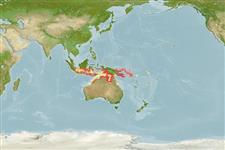Common names from other countries
Environment: milieu / climate zone / depth range / distribution range
Ecologia
marinhas; Água doce; estuarina demersal; pH range: 7.5 - 8.2; dH range: 18 - 30; anádromo. Tropical; 24°C - 32°C (Ref. 2059); 3°S - 19°S
Western Pacific: northern Australia and southern New Guinea.
Tamanho / Peso / Idade
Maturity: Lm ? range ? - ? cm
Max length : 60.0 cm SL macho/indeterminado; (Ref. 44894)
Espinhos dorsais (total): 1; Raios dorsais (total): 7; Espinhos anais 0; Raios anais : 15 - 19
Adults inhabit freshwater rivers and lagoons, as well as brackish estuaries and coastal marine waters. Can tolerate temperatures from 11°C to 38°C. Large groups of juveniles are often encountered (Ref. 44894). Feed on arthropods, insects, aquatic plants, mollusks, prawns, crayfish, fishes and bottom detritus. Nest is constructed among gravel where eggs are deposited forming a mound (Ref. 205). The only species among oral incubating ariids exhibiting no parental care (Ref. 205). Breeding takes place from September to February (Ref. 44894). Marine populations of A. graeffei appear to undertake extensive anadromous migrations associated with breeding, but no such movements were observed in the fluviatile population studied (Ref. 38559).
Ciclo de vida ou comportamento de acasalamento
Maturidade | Reprodução | Desova | Ovos | Fecundidade | Larvas
Nest is constructed among gravel where eggs are deposited forming a mound (Ref. 205). The only species among oral incubating Ariidae exhibiting no parental care (Ref. 205).
Allen, G.R., 1989. Freshwater fishes of Australia. T.F.H. Publications, Inc., Neptune City, New Jersey. (Ref. 5259)
Status na Lista Vermelha da UICN (Ref. 130435)
CITES (Ref. 128078)
Not Evaluated
Ameaça para os humanos
Traumatogenic (Ref. 58010)
Uso pelos humanos
Mais informação
ReferênciasAquaculturaPerfil para aquaculturaEstirpesGenéticaElectrophoresesHereditariedadeDoençasProcessamentoConversão de massa
ColaboradoresFotosStamps, Coins Misc.SonsCiguateraVelocidadeTipo de nataçãoÁrea branquialOtólitosCérebrosVisão
Ferramentas
Relatórios especiais
Baixar XML
Fontes da internet
Estimates based on models
Preferred temperature (Ref.
115969): 26.7 - 28.7, mean 27.9 (based on 270 cells).
Índice de diversidade filogenética (Ref.
82804): PD
50 = 0.5010 [Uniqueness, from 0.5 = low to 2.0 = high].
Bayesian length-weight: a=0.00813 (0.00384 - 0.01719), b=3.06 (2.88 - 3.24), in cm Total Length, based on LWR estimates for this (Sub)family-body shape (Ref.
93245).
Nível Trófico (Ref.
69278): 3.6 ±0.2 se; based on diet studies.
Resiliência (Ref.
120179): médio(a), tempo mínimo de duplicação da população 1,4 - 4,4 anos (Preliminary K or Fecundity.).
Fishing Vulnerability (Ref.
59153): Moderate to high vulnerability (49 of 100).
